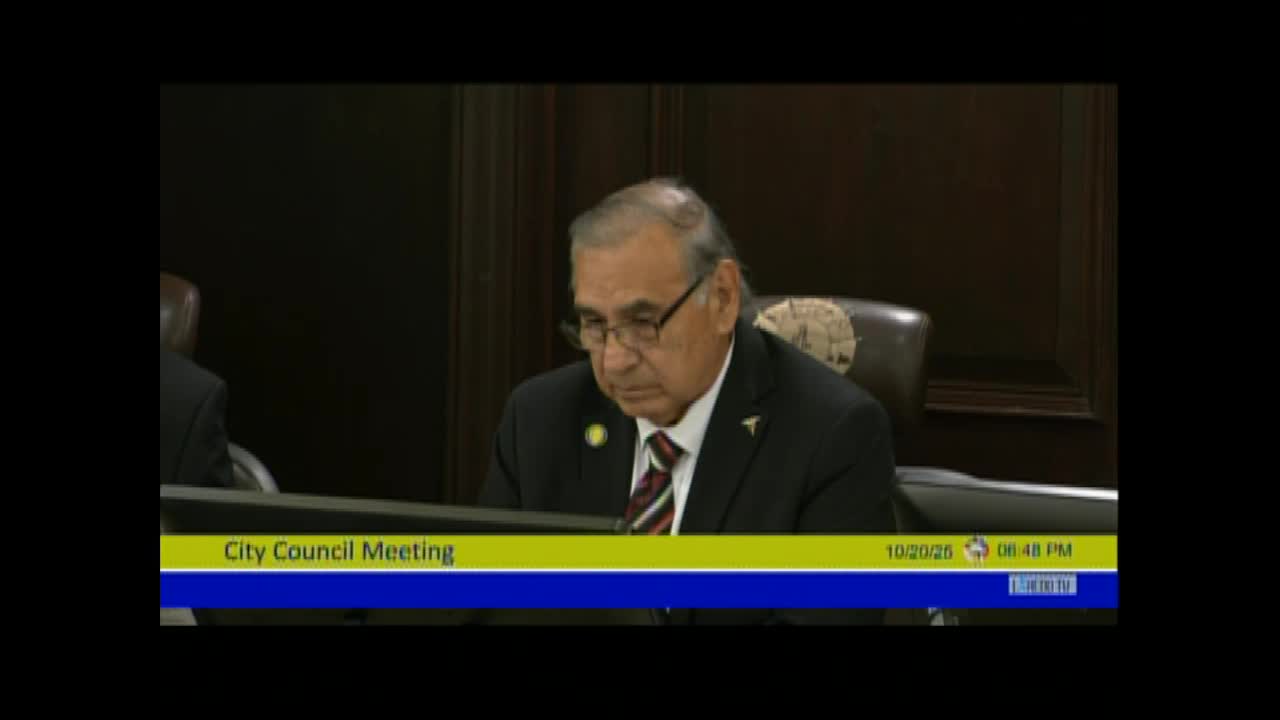Laredo council backs push for Mexico to make overdue Rio Grande water deliveries, urges treaty update
October 20, 2025 | Laredo, Webb County, Texas
This article was created by AI summarizing key points discussed. AI makes mistakes, so for full details and context, please refer to the video of the full meeting. Please report any errors so we can fix them. Report an error »

The Laredo City Council voted Oct. 20 to support a South Texas mayors’ request that Mexico deliver outstanding water owed under the 1944 U.S.–Mexico water treaty and to place modernization of the treaty on a priority list for an upcoming trip to Washington, D.C.
Mayor Victor D. Trevino said the action supports an existing South Texas Alliance of Cities letter asking Mexico to pay the water amounts agreed under the treaty. “Mexico must pay The United States 1,750,000 acre‑feet of water every five years,” Mayor Trevino said. “The current cycle ends Oct. 25; Mexico had delivered 807,980 acre‑feet, leaving an unpaid balance of roughly 942,020 acre‑feet, according to the International Boundary and Water Commission.”
A council member responding to the motion noted the complexity of the binational system that fills Amistad Reservoir and the role of tributaries such as the Rio Conchos. The council member said Mexico’s ability to deliver additional water in 2025 depends partly on reservoir storage in the Rio Conchos watershed and that forcing immediate repayment could have unintended consequences if Mexico draws from its own reservoirs.
The council passed a motion to prioritize the water issue for the city’s federal advocacy, to seek technical conversations with Mexican counterparts and U.S. agencies, and to pursue modernization of treaty mechanisms. The motion passed by voice vote after a second; the mayor and council did not specify punitive measures but directed staff to prepare materials for the Washington, D.C., trip and to engage the city’s lobbyists.
Council members discussed seeking binational technical initiatives — for example, water‑conservation and irrigation‑efficiency programs — to reduce pressure on supply and to support regional agriculture. Officials said Laredo’s position as a major port of entry gives the city credibility to convene technical and policy discussions on water deliverables and drought resilience.
The council’s action was framed as both a short‑term request for Mexico to meet near‑term treaty obligations and as a longer‑term push to modernize treaty metrics to reflect current demand and climate pressures.
Mayor Victor D. Trevino said the action supports an existing South Texas Alliance of Cities letter asking Mexico to pay the water amounts agreed under the treaty. “Mexico must pay The United States 1,750,000 acre‑feet of water every five years,” Mayor Trevino said. “The current cycle ends Oct. 25; Mexico had delivered 807,980 acre‑feet, leaving an unpaid balance of roughly 942,020 acre‑feet, according to the International Boundary and Water Commission.”
A council member responding to the motion noted the complexity of the binational system that fills Amistad Reservoir and the role of tributaries such as the Rio Conchos. The council member said Mexico’s ability to deliver additional water in 2025 depends partly on reservoir storage in the Rio Conchos watershed and that forcing immediate repayment could have unintended consequences if Mexico draws from its own reservoirs.
The council passed a motion to prioritize the water issue for the city’s federal advocacy, to seek technical conversations with Mexican counterparts and U.S. agencies, and to pursue modernization of treaty mechanisms. The motion passed by voice vote after a second; the mayor and council did not specify punitive measures but directed staff to prepare materials for the Washington, D.C., trip and to engage the city’s lobbyists.
Council members discussed seeking binational technical initiatives — for example, water‑conservation and irrigation‑efficiency programs — to reduce pressure on supply and to support regional agriculture. Officials said Laredo’s position as a major port of entry gives the city credibility to convene technical and policy discussions on water deliverables and drought resilience.
The council’s action was framed as both a short‑term request for Mexico to meet near‑term treaty obligations and as a longer‑term push to modernize treaty metrics to reflect current demand and climate pressures.
View full meeting
This article is based on a recent meeting—watch the full video and explore the complete transcript for deeper insights into the discussion.
View full meeting
